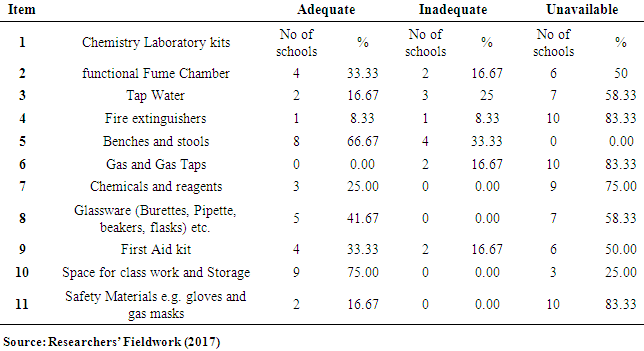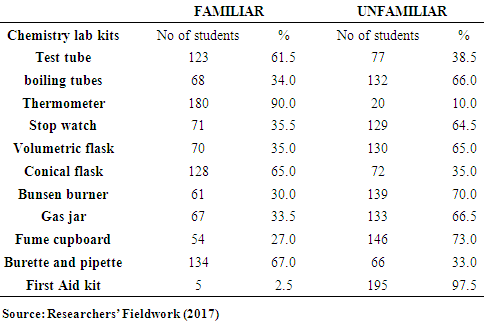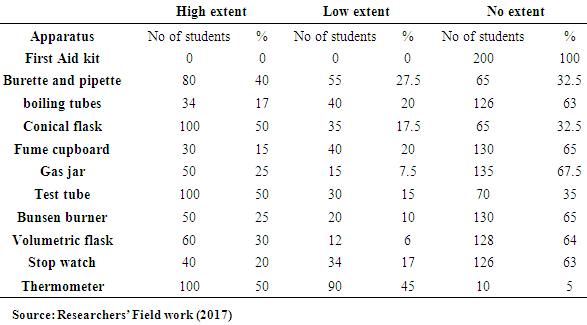-
Paper Information
- Paper Submission
-
Journal Information
- About This Journal
- Editorial Board
- Current Issue
- Archive
- Author Guidelines
- Contact Us
American Journal of Mathematics and Statistics
p-ISSN: 2162-948X e-ISSN: 2162-8475
2017; 7(4): 160-165
doi:10.5923/j.ajms.20170704.03

Availability and Utilization of Laboratory Kits for Practical Teaching of Mathematical Skills in Chemistry
A. A. Arokoyu, G. I. Charles-Ogan
Department of Curriculum Studies/Educational Technology, Faculty of Education, University of Port Harcourt, Nigeria
Correspondence to: G. I. Charles-Ogan, Department of Curriculum Studies/Educational Technology, Faculty of Education, University of Port Harcourt, Nigeria.
| Email: |  |
Copyright © 2017 Scientific & Academic Publishing. All Rights Reserved.
This work is licensed under the Creative Commons Attribution International License (CC BY).
http://creativecommons.org/licenses/by/4.0/

This study investigated the availability and utilisation of laboratory kits for practical teaching of mathematics in chemistry in Ahoada West local government area of Rivers State. A descriptive research design was adopted in carrying out this study. The population of the study was all public senior secondary I (SS1) chemistry students in Ahoada West education zone of Rivers State. A total of two hundred (200) chemistry students were used as a sample for the study which comprises one hundred and twenty (120) male, and eighty (80) female. Four research questions guided the study. The data were analysed using frequency counts and percentages. A structured questionnaire was the instrument used for data collection, and the instrument was face validated by three experts. Reliability coefficient index of 0.76 was obtained using the test-retest method. The result revealed that the availability and utilisation of laboratory kits in the sampled senior secondary schools were inadequate. Based on the result, it was recommended that the government at all levels of education should endeavour to make adequate provision of laboratory kits for the practical teaching of mathematics in chemistry, besides chemistry teachers, should ensure that students are introduced to the use of the few available apparatus during practical classes.
Keywords: Mathematics, Chemistry
Cite this paper: A. A. Arokoyu, G. I. Charles-Ogan, Availability and Utilization of Laboratory Kits for Practical Teaching of Mathematical Skills in Chemistry, American Journal of Mathematics and Statistics, Vol. 7 No. 4, 2017, pp. 160-165. doi: 10.5923/j.ajms.20170704.03.
Article Outline
1. Introduction
- Mathematics is not just a core science subject but a precision tool employed by all scientists in their search for a clear understanding of the physical world as well as for the development of any science-based discipline. It is the language, as well as a tool of science and engineering. Mathematical knowledge plays a crucial role in understanding the contents of other school subjects such as science, social studies, and even music and art. Mathematical concepts and procedures are used to solve problems in science, engineering, medicine, economics and so on. Any scientific education which does not commence with mathematics is said to be defective in its foundation. Mathematics is related to many things in human’s daily life and its study provides students with certain basic life skills and processes that prepare them to be productive members of the society. Azuka (2015) emphasised that Mathematical skills relevant to a wide range of analytical, technological, scientific, security, political and economic applications hence the solid foundation in mathematics prepare one for other educational and professional challenges.On the other hand, Chemistry is a natural science which studies composition, structure, properties and change of matter. Matter, from the chemical point of view, consists of the substances encountered in daily life in whatever phase such as solid, liquids, gaseous and plasma, as well as the atoms and molecules of which these substances are composed. Chemists move among these ideas to come up with explanations of how matter behaves. Since much of chemistry deals with atomic and molecular phenomena that cannot be observed in the secondary school classroom, analogies and models are only used for delivery of instruction. Within the context of science education, Chemistry has been identified as a very important science subject and its importance in the scientific and technological development of any nation has been widely reported. It was as a result of the recognition given to Chemistry in the development of the individual and the nation that it was made a core – subject among the natural sciences and other science – related courses in Nigerian education system. It has been a pre-requisite subject for offering most science oriented courses in the tertiary institution and this calls for the need to teach it effectively. Chemistry is important in many aspects of life. It is a key subject in most careers in the education system. These include but not limited to; Medicine, Veterinary Medicine, Nursing, Engineering and Biotechnology among others. Chemistry is also a key subject for the development of Science and Technology in any country. Within the context of science education, Chemistry has been identified as a very important science subject and its importance in the scientific and technological development of any nation has been widely reported (Adesoji & Olatunbosun, 2008).Mathematics is used widely in chemistry as well as all other sciences. Mathematical calculations are absolutely necessary to explore important concepts in chemistry. Without some basic mathematics skills, these calculations would be impossible and therefore chemistry itself will be extremely difficult. However, with a basic knowledge of some of the mathematics that is used in chemistry, the students will be well equipped to deal with the concepts and theories of Chemistry. The more mathematics background an individual possesses, the greater the likelihood of meeting success in chemistry. So also, students with a poor background in mathematics will have fewer opportunities to succeed in chemistry. According to Odili (2006), achievement in sciences is often contingent upon mathematics knowledge and the ability to perform mathematical operations. Mathematical concepts and procedures are used to solve problems in various fields and disciplines including chemistry. Salau (2000) pointed out that there exists an impregnable link between mathematics and other science subjects. For example, the teaching of the practical aspect of chemistry can hardly be achieved without the knowledge of mathematics.Odili (2006) writing on mathematics topics related to chemistry suggested that fractions and decimals, axes and scales, line graph, addition and subtraction, logarithm numbers – use of four figure tables, indices, ratio and proportions, direct and inverse variation, substitution of values in an algebraic expression, and change of subject in a formula should be studied by chemistry students at the Senior Secondary School level. Mathematical confidence and problem-solving ability are probably the most important factors in predicting the success of students in chemistry. A strong foundation of mathematics skills improves performance in chemistry. Knowledge and skills in the areas of basic mathematics, calculus, and 3-dimensional geometry can be used as prerequisites or co-requisites to general chemistry. It is unlikely that a student will excel in general chemistry without a solid understanding or and familiarity with the following elementary topics: (i) unit conversions (ii) significant figures(iii) proportions and concentrations (iv) expressions involving exponents and logarithms (v) basic trigonometry and algebra including graphing (vi) summation notation (vii) very basic probability and statistics (viii) applications of all of the above to word problems Despite the prime position Chemistry occupies in our educational system and the efforts made by researchers to enhance performance, students’ performance in chemistry and sciences, in general, are still low. Two of the reasons identified for this failure are laboratory inadequacy and the environment. The adequacy and use of educational resources like laboratory kits enhance the effectiveness of teachers’ lesson and understanding of abstract ideas and improve performance. Chemistry teaching is supposed to be result oriented and students centred, and this can only be achieved when students are willing and the teachers are favourably disposed to, using the appropriate methods and resources in teaching the students. Students by nature are curious; they need to be actively involved in the learning process in which they are continuously experimenting, testing, speculating and building their own personal construct and knowledge. It is only by personalising such knowledge that it becomes valid, meaningful and useful to them. In chemistry, students need to actively construct their own personal awareness and meaning (Usman, 2000). To substantiate the argument, Usman (2006) remarked that the brain is not a passive consumer of information and to learn with understanding, a learner must actively construct the meaning of what to be learned.There is no doubt about the notion that chemistry is abstract in nature, its abstract nature brings about learning difficulty most especially in the mathematical aspect of chemistry. Observations have shown that in spite of the various innovations introduced into science teaching in general and chemistry. In particular, the performance of students still remains low (Fatoke, 2013). Laboratories are of utmost importance in the teaching and learning of science subjects of which Chemistry Central. A Chemistry Laboratory offers the environment and resources for teaching practical Chemistry skills which help students handle examination and the day to day affairs. When the students are given the chance to learn through more senses than one, they can learn faster and easier. The use of laboratory kit materials provides the teacher with interesting and compelling platforms for conveying information since the laboratory materials motivate learners to learn more. Hence the teacher is assisted in overcoming physical difficulties that could have hindered his effective presentation of a given topic. The use of laboratory kits for teaching does not only encourage teachers and students to work collaboratively but also results in more cooperative learning activities among the students. Effective practical activities enable students to build a bridge between what they can see, handle and scientific ideas that account for their observations. The chemistry laboratory represents a wonderful opportunity for making the connection between the unseen microscopic world and the observable macroscopic world in which we live. Laboratory experiences provide opportunities for team building, inquiry-based learning, hands-on activities, and exposure to standard laboratory equipment and technology. Chemistry is a laboratory science and cannot be effectively learned without laboratory experiences. Indeed, the identification, manipulation, and general use of laboratory equipment are integral parts of the subject of chemistry. Many, if not most, of the concepts and principles common in secondary school chemistry, can be demonstrated or delivered through experiments performed with simple apparatus. This study, therefore, investigated the extent of availability and utilisation of Chemistry laboratories kits in teaching and learning the practical teaching of mathematics in chemistry in Ahoada West local government area of Rivers State. Statement of the problemChemistry as one of the core subjects for students with science bias in senior secondary school is supposed to be result oriented and students centred. This can only be achieved when students are willing and the teachers are favourably disposed to using the appropriate methods and resources in teaching the subject. As a subject, chemistry is required for certification at the secondary level for admission into a higher institution in the field of science, engineering, and medicine. Students seem to have a challenge with chemistry especially in the aspect of calculations and this has affected their achievement and performance. Hence, this study investigated the availability and utilisation of laboratory kits for the practical teaching of mathematics in chemistry with a view to improving the performance of students in calculations in chemistry. For a good performance to be realised in chemistry, laboratory kits availability and utilisation are therefore of paramount importance. The problem of this study was to provide baseline information on the availability and utilisation of laboratory kits for the practical teaching of mathematics in chemistry in senior secondary schools Rivers State.Purpose of the studyThe study investigated the availability and utilisation of laboratory kits for the practical teaching of mathematics in chemistry in some selected senior secondary schools in Ahoada West local government area of Rivers State. The specific objectives of the study are to:1. investigate the availability of chemistry laboratory in the senior secondary schools in Ahoada West local government area of Rivers State, Nigeria;2. assess the availability of chemistry laboratory kits in the senior secondary schools in Ahoada West local government area of Rivers State, Nigeria; 3. evaluate the extent of use of chemistry laboratory by chemistry teachers in the senior secondary schools; and4. explore the extent of use of laboratory kits by chemistry students in the senior secondary schools.Research Questions:This study seeks to fill the void through addressing the following research questions:1. Is chemistry laboratory available for the teaching of Mathematics in Chemistry in Ahoada West?2. To what extent are chemistry laboratory kits available for the teaching of Mathematics in Chemistry in the senior secondary schools Ahoada West?3. What is the extent of use of laboratory kits by chemistry teachers in the senior secondary schools?4. What is the extent of use of laboratory kits by chemistry students in the senior secondary schools?
2. Methodology
- This study adopted descriptive survey design. The researchers used simple random sampling techniques as well as purposive sampling to get the sample of respondents for the study. The population consisted of all the SS1 students in senior secondary schools in Ahoada West education zone of Rivers State. The sample for this study comprised of 200 students (120) male and (80) female selected from twelve senior secondary schools in Ahoada West education zone of Rivers State. Instrument for Data CollectionThe instrument used for data collection is a questionnaire named Availability and Utilisation of Chemistry Laboratory Kits (AUCLK) structured by the researchers. The questionnaire (AUCLK) was divided into two sections, A and B. Section A is concerned with the data needed on the availability of Chemistry laboratory kits in schools. Section ‘B’ obtained information on the utilisation of Chemistry laboratory kits in schools. Furthermore, section A contains Chemistry laboratory, while section B contains Chemistry laboratory kits items. Hence, the instrument for data collection has eleven (11) items on the whole.Validation of the InstrumentsThe instrument was content and construct validated by 3 experts from the Department of Curriculum Studies Rivers State University of Science and Technology University Port Harcourt (RUST).Reliability of the InstrumentThe reliability of the instrument was determined using test re-test method on thirty respondents from Ahoada East education zone. The reliability coefficient of 0.76 was obtained using Pearson’s product moment correlation.Administration of the InstrumentA total of two hundred questionnaire copies were administered to chemistry students of the sampled schools. All the copies of the questionnaire were received and analysed. Data were analysed using frequency count and percentages.
3. Results
- The results of the study were obtained from the research questions answered through data collected and analysed.Research Question 1: Are chemistry laboratory available for the teaching of Mathematics in Chemistry?
|
|
|
|
4. Discussion
- Overall analysis of the data on the availability of chemistry laboratory and chemistry laboratory kits shows that most schools have laboratories as buildings. Further, the findings showed that there was adequate space in the laboratories. The study revealed inadequacy in chemistry laboratories. This result revealed the inadequacy of teaching and learning kits for mathematics in chemistry in the senior secondary schools. The study showed that there are schools within Rivers State which to date still do not have chemistry laboratories. Very little practical work, most of the form of teacher demonstration was said to be taking place in such schools. In other schools, though a laboratory was available, they were found to be insufficient because they were also being used for the teaching and learning of the other science subjects. Some of the laboratories were found to be lacking some important equipment and facilities. These included fume chamber, running water and gas taps. It was also discovered that most laboratories lacked a first aid kit. It is advisable to have the kit because while in the laboratory accidents can occur. Furthermore, no single school had adequate safety materials like gloves and gas masks. They were either inadequate or not available in all the schools visited. Safety of teachers and students should always be catered for.Laboratory apparatus and facilities availability is, therefore, one of the major causes of students’ poor performance in Chemistry in senior secondary schools.
5. Summary of Findings
- The study found that there are still some senior secondary schools which do not have chemistry laboratory kits. Those without laboratories, however, had some apparatus and chemicals stored in a room. Only a few senior secondary schools among the 12 sampled could be said to have adequately equipped laboratories. Noticeably missing from most of the laboratories were fume chambers, first aid kits and protective gear such as gloves and masks. Most of the teachers did not seem to like handling Chemistry practical work in the laboratory for various reasons.
6. Conclusions
- From the research findings of this study, it is clear that utilisation of laboratories in the sampled senior secondary schools is inadequate. This according to some respondents was due to the availability of apparatus which implies that the chemistry syllabus is not always well covered. Some students were not familiar with the use of some apparatus effectively.
7. Recommendations
- The study recommends that:i. All stakeholders especially the government and Parents Teachers Association (PTA) should ensure that Chemistry laboratory is adequately equipped with all the required teaching and learning kits for the practical teaching of mathematics in Chemistry. ii. Chemistry teachers should ensure that students are introduced to the use of all the apparatus during their practical classes.
 Abstract
Abstract Reference
Reference Full-Text PDF
Full-Text PDF Full-text HTML
Full-text HTML


